Apache ShenYu 是一个异步的,高性能的,跨语言的,响应式的 API 网关。
在ShenYu网关中,数据同步是指,当在后台管理系统中,数据发送了更新后,如何将更新的数据同步到网关中。Apache ShenYu 网关当前支持ZooKeeper、WebSocket、Http长轮询、Nacos 、Etcd 和 Consul 进行数据同步。本文的主要内容是基于Http长轮询的数据同步源码分析。
本文基于shenyu-2.4.0版本进行源码分析,官网的介绍请参考 数据同步原理 。
1. Http 长轮询
这里直接引用官网的相关描述:
Zookeeper和WebSocket 数据同步的机制比较简单,而 Http长轮询则比较复杂。 Apache ShenYu 借鉴了 Apollo、Nacos 的设计思想,取其精华,自己实现了 Http长轮询数据同步功能。注意,这里并非传统的 ajax 长轮询!
Http长轮询 机制如上所示,Apache ShenYu网关主动请求 shenyu-admin 的配置服务,读取超时时间为 90s,意味着网关层请求配置服务最多会等待 90s,这样便于 shenyu-admin 配置服务及时响应变更数据,从而实现准实时推送。
Http长轮询 机制是由网关主动请求 shenyu-admin ,所以这次的源码分析,我们从网关这一侧开始。
2. 网关数据同步
2.1 加载配置
Http长轮询 数据同步配置的加载是通过spring boot的starter机制,当我们引入相关依赖和在配置文件中有如下配置时,就会加载。
在pom文件中引入依赖:
<!--shenyu data sync start use http--> <dependency> <groupId>org.apache.shenyu</groupId> <artifactId>shenyu-spring-boot-starter-sync-data-http</artifactId> <version>${project.version}</version> </dependency>
复制代码
在application.yml配置文件中添加配置:
shenyu: sync: http: url : http://localhost:9095
复制代码
当网关启动时,配置类HttpSyncDataConfiguration就会执行,加载相应的Bean。
/** * Http sync data configuration for spring boot. */@Configuration@ConditionalOnClass(HttpSyncDataService.class)@ConditionalOnProperty(prefix = "shenyu.sync.http", name = "url")@Slf4jpublic class HttpSyncDataConfiguration {
/** * Http sync data service. * 创建 HttpSyncDataService * @param httpConfig http的配置 * @param pluginSubscriber 插件数据订阅 * @param metaSubscribers 元数据订阅 * @param authSubscribers 认证数据订阅 * @return the sync data service */ @Bean public SyncDataService httpSyncDataService(final ObjectProvider<HttpConfig> httpConfig, final ObjectProvider<PluginDataSubscriber> pluginSubscriber, final ObjectProvider<List<MetaDataSubscriber>> metaSubscribers, final ObjectProvider<List<AuthDataSubscriber>> authSubscribers) { log.info("you use http long pull sync shenyu data"); return new HttpSyncDataService(Objects.requireNonNull(httpConfig.getIfAvailable()), Objects.requireNonNull(pluginSubscriber.getIfAvailable()), metaSubscribers.getIfAvailable(Collections::emptyList), authSubscribers.getIfAvailable(Collections::emptyList)); }
/** * Http config http config. * 读取http的配置 * @return the http config */ @Bean @ConfigurationProperties(prefix = "shenyu.sync.http") public HttpConfig httpConfig() { return new HttpConfig(); }}
复制代码
HttpSyncDataConfiguration是Http长轮询数据同步的配置类,负责创建HttpSyncDataService(负责http数据同步的具体实现)和HttpConfig(admin属性配置)。它的注解如下:
@Configuration:表示这是一个配置类;
@ConditionalOnClass(HttpSyncDataService.class):条件注解,表示要有HttpSyncDataService这个类;
@ConditionalOnProperty(prefix = "shenyu.sync.http", name = "url"):条件注解,要有shenyu.sync.http.url这个属性配置。
2.2 属性初始化
在HttpSyncDataService的构造函数中,完成属性初始化。
public class HttpSyncDataService implements SyncDataService, AutoCloseable {
// 省略了属性字段......
public HttpSyncDataService(final HttpConfig httpConfig, final PluginDataSubscriber pluginDataSubscriber, final List<MetaDataSubscriber> metaDataSubscribers, final List<AuthDataSubscriber> authDataSubscribers) { // 1.创建数据处理器 this.factory = new DataRefreshFactory(pluginDataSubscriber, metaDataSubscribers, authDataSubscribers); // 2.获取admin属性配置 this.httpConfig = httpConfig; // shenyu-admin的url, 多个用逗号(,)分割 this.serverList = Lists.newArrayList(Splitter.on(",").split(httpConfig.getUrl())); // 3.创建httpClient,用于向admin发起请求 this.httpClient = createRestTemplate(); // 4.开始执行长轮询任务 this.start(); }
//......}
复制代码
上面代码中省略了其他函数和相关字段,在构造函数中完成属性的初始化,主要是:
创建数据处理器,用于后续缓存各种类型的数据(插件、选择器、规则、元数据和认证数据);
获取admin属性配置,主要是获取admin的url,admin有可能是集群,多个用逗号(,)分割;
创建httpClient,使用的是RestTemplate,用于向admin发起请求;
private RestTemplate createRestTemplate() { OkHttp3ClientHttpRequestFactory factory = new OkHttp3ClientHttpRequestFactory(); // 建立连接超时时间为 10s factory.setConnectTimeout((int) this.connectionTimeout.toMillis()); // 网关主动请求 shenyu-admin 的配置服务,读取超时时间为 90s factory.setReadTimeout((int) HttpConstants.CLIENT_POLLING_READ_TIMEOUT); return new RestTemplate(factory); }
复制代码
2.3 开始长轮询
在start()方法中,干了两件事情,一个是获取全量数据,即请求admin端获取所有需要同步的数据,然后将获取到的数据缓存到网关内存中。另一个是开启多线程执行长轮询任务。
private void start() { // 只初始化一次,通过原子类实现。 RUNNING = new AtomicBoolean(false); // It could be initialized multiple times, so you need to control that. if (RUNNING.compareAndSet(false, true)) { // fetch all group configs. // 初次启动,获取全量数据 this.fetchGroupConfig(ConfigGroupEnum.values());
// 一个后台服务,一个线程 int threadSize = serverList.size(); // 自定义线程池 this.executor = new ThreadPoolExecutor(threadSize, threadSize, 60L, TimeUnit.SECONDS, new LinkedBlockingQueue<>(), ShenyuThreadFactory.create("http-long-polling", true)); // start long polling, each server creates a thread to listen for changes. // 开始长轮询,一个admin服务,创建一个线程用于数据同步 this.serverList.forEach(server -> this.executor.execute(new HttpLongPollingTask(server))); } else { log.info("shenyu http long polling was started, executor=[{}]", executor); } }
复制代码
2.3.1 获取全量数据
ShenYu将所有需要同步的数据进行了分组,一共有 5 种数据类型,分别是插件、选择器、规则、元数据和认证数据。
public enum ConfigGroupEnum { APP_AUTH, // 认证数据 PLUGIN, //插件 RULE, // 规则 SELECTOR, // 选择器 META_DATA; // 元数据}
复制代码
admin有可能是集群,这里通过循环的方式向每个admin发起请求,有一个执行成功了,那么向admin获取全量数据并缓存到网关的操作就执行成功。如果出现了异常,就向下一个admin发起请求。
private void fetchGroupConfig(final ConfigGroupEnum... groups) throws ShenyuException { // admin有可能是集群,这里通过循环的方式向每个admin发起请求 for (int index = 0; index < this.serverList.size(); index++) { String server = serverList.get(index); try { // 真正去执行 this.doFetchGroupConfig(server, groups); // 有一个成功,就成功了,可以退出循环 break; } catch (ShenyuException e) { // 出现异常,尝试执行下一个 // 最后一个也执行失败了,抛出异常 // no available server, throw exception. if (index >= serverList.size() - 1) { throw e; } log.warn("fetch config fail, try another one: {}", serverList.get(index + 1)); } } }
复制代码
在此方法中,首先拼装请求参数,然后通过httpClient发起请求,到admin中获取数据,最后将获取到的数据更新到网关内存中。
// 向admin后台管理系统发起请求,获取所有同步数据private void doFetchGroupConfig(final String server, final ConfigGroupEnum... groups) { // 1. 拼请求参数,所有分组枚举类型 StringBuilder params = new StringBuilder(); for (ConfigGroupEnum groupKey : groups) { params.append("groupKeys").append("=").append(groupKey.name()).append("&"); }
// admin端提供的接口 /configs/fetch String url = server + "/configs/fetch?" + StringUtils.removeEnd(params.toString(), "&"); log.info("request configs: [{}]", url); String json = null; try { // 2. 发起请求,获取变更数据 json = this.httpClient.getForObject(url, String.class); } catch (RestClientException e) { String message = String.format("fetch config fail from server[%s], %s", url, e.getMessage()); log.warn(message); throw new ShenyuException(message, e); } // update local cache // 3. 更新网关内存中数据 boolean updated = this.updateCacheWithJson(json); // 更新成功,此方法就执行完成了 if (updated) { log.info("get latest configs: [{}]", json); return; } // not updated. it is likely that the current config server has not been updated yet. wait a moment. log.info("The config of the server[{}] has not been updated or is out of date. Wait for 30s to listen for changes again.", server); // 服务端没有数据更新,就等30s ThreadUtils.sleep(TimeUnit.SECONDS, 30);}
复制代码
从代码中,可以看到 admin端提供的获取全量数据接口是 /configs/fetch,这里先不进一步深入,放在后文再分析。
获取到admin返回结果数据,并成功更新,那么此方法就执行结束了。如果没有更新成功,那么有可能是服务端没有数据更新,就等待30s。
这里需要提前说明一下,网关在判断是否更新成功时,有比对数据的操作,马上就会提到。
更新网关内存中的数据。使用GSON进行反序列化,从属性data中拿真正的数据,然后交给DataRefreshFactory去做更新。
private boolean updateCacheWithJson(final String json) { // 使用GSON进行反序列化 JsonObject jsonObject = GSON.fromJson(json, JsonObject.class); JsonObject data = jsonObject.getAsJsonObject("data"); // if the config cache will be updated? return factory.executor(data); }
复制代码
根据不同数据类型去更新数据,返回更新结果。这里采用了parallelStream()进行并行更新,具体更新逻辑交给了dataRefresh.refresh()方法。在更新结果中,有一种数据类型进行了更新,就表示此次操作发生了更新。
public boolean executor(final JsonObject data) { //并行更新数据 List<Boolean> result = ENUM_MAP.values().parallelStream() .map(dataRefresh -> dataRefresh.refresh(data)) .collect(Collectors.toList()); //有一个更新就表示此次发生了更新操作 return result.stream().anyMatch(Boolean.TRUE::equals); }
复制代码
数据更新逻辑采用的是模板方法设计模式,通用操作在抽象方法中完成,不同的实现逻辑由子类完成。5 种数据类型具体的更新逻辑有些差异,但是也存在通用的更新逻辑,类图关系如下:
在通用的refresh()方法中,负责数据类型转换,判断是否需要更新,和实际的数据刷新操作。
@Override public Boolean refresh(final JsonObject data) { boolean updated = false; // 数据类型转换 JsonObject jsonObject = convert(data); if (null != jsonObject) { // 得到数据类型 ConfigData<T> result = fromJson(jsonObject); // 是否需要更新 if (this.updateCacheIfNeed(result)) { updated = true; // 真正的更新逻辑,数据刷新操作 refresh(result.getData()); } } return updated; }
复制代码
数据转换的过程,就是根据不同的数据类型进行转换,我们就不再进一步追踪了,看看数据是否需要更新的逻辑。方法名是updateCacheIfNeed(),通过方法重载实现。
// result是数据protected abstract boolean updateCacheIfNeed(ConfigData<T> result);
// newVal是获取到的最新的值// groupEnum 是哪种数据类型protected boolean updateCacheIfNeed(final ConfigData<T> newVal, final ConfigGroupEnum groupEnum) { // 如果是第一次,那么直接放到cache中,返回 true,表示此次进行了更新 if (GROUP_CACHE.putIfAbsent(groupEnum, newVal) == null) { return true; } ResultHolder holder = new ResultHolder(false); GROUP_CACHE.merge(groupEnum, newVal, (oldVal, value) -> { // md5 值相同,不需要更新 if (StringUtils.equals(oldVal.getMd5(), newVal.getMd5())) { log.info("Get the same config, the [{}] config cache will not be updated, md5:{}", groupEnum, oldVal.getMd5()); return oldVal; }
// 当前缓存的数据修改时间大于 新来的数据,不需要更新 // must compare the last update time if (oldVal.getLastModifyTime() >= newVal.getLastModifyTime()) { log.info("Last update time earlier than the current configuration, the [{}] config cache will not be updated", groupEnum); return oldVal; } log.info("update {} config: {}", groupEnum, newVal); holder.result = true; return newVal; }); return holder.result; }
复制代码
从上面的源码中可以看到,有两种情况不需要更新:
其他情况需要更新数据。
分析到这里,就将start() 方法中初次启动,获取全量数据的逻辑分析完了,接下来是长轮询的操作。为了方便,我将start()方法再粘贴一次:
private void start() { // It could be initialized multiple times, so you need to control that. if (RUNNING.compareAndSet(false, true)) { // fetch all group configs. // 初次启动,获取全量数据 this.fetchGroupConfig(ConfigGroupEnum.values());
// 一个后台服务,一个线程 int threadSize = serverList.size(); // 自定义线程池 this.executor = new ThreadPoolExecutor(threadSize, threadSize, 60L, TimeUnit.SECONDS, new LinkedBlockingQueue<>(), ShenyuThreadFactory.create("http-long-polling", true)); // start long polling, each server creates a thread to listen for changes. // 开始长轮询,一个admin服务,创建一个线程用于数据同步 this.serverList.forEach(server -> this.executor.execute(new HttpLongPollingTask(server))); } else { log.info("shenyu http long polling was started, executor=[{}]", executor); } }
复制代码
2.3.2 执行长轮询任务
长轮询任务是HttpLongPollingTask,它实现了Runnable接口,任务逻辑在run()方法中。通过while()循环实现不断执行任务,即长轮询。在每一次的轮询中有三次重试逻辑,一次轮询任务失败了,等 5s 再继续,3 次都失败了,等 5 分钟再试。
开始长轮询,一个admin服务,创建一个线程用于数据同步。
class HttpLongPollingTask implements Runnable {
private String server;
// 默认重试 3 次 private final int retryTimes = 3;
HttpLongPollingTask(final String server) { this.server = server; }
@Override public void run() { // 一直轮询 while (RUNNING.get()) { for (int time = 1; time <= retryTimes; time++) { try { doLongPolling(server); } catch (Exception e) { // print warnning log. if (time < retryTimes) { log.warn("Long polling failed, tried {} times, {} times left, will be suspended for a while! {}", time, retryTimes - time, e.getMessage()); // 长轮询失败了,等 5s 再继续 ThreadUtils.sleep(TimeUnit.SECONDS, 5); continue; } // print error, then suspended for a while. log.error("Long polling failed, try again after 5 minutes!", e); // 3 次都失败了,等 5 分钟再试 ThreadUtils.sleep(TimeUnit.MINUTES, 5); } } } log.warn("Stop http long polling."); } }
复制代码
执行长轮询任务的核心逻辑:
private void doLongPolling(final String server) { // 组装请求参数:md5 和 lastModifyTime MultiValueMap<String, String> params = new LinkedMultiValueMap<>(8); for (ConfigGroupEnum group : ConfigGroupEnum.values()) { ConfigData<?> cacheConfig = factory.cacheConfigData(group); if (cacheConfig != null) { String value = String.join(",", cacheConfig.getMd5(), String.valueOf(cacheConfig.getLastModifyTime())); params.put(group.name(), Lists.newArrayList(value)); } } // 组装请求头和请求体 HttpHeaders headers = new HttpHeaders(); headers.setContentType(MediaType.APPLICATION_FORM_URLENCODED); HttpEntity httpEntity = new HttpEntity(params, headers); String listenerUrl = server + "/configs/listener"; log.debug("request listener configs: [{}]", listenerUrl); JsonArray groupJson = null; //向admin发起请求,判断组数据是否发生变更 //这里只是判断了某个组是否发生变更 try { String json = this.httpClient.postForEntity(listenerUrl, httpEntity, String.class).getBody(); log.debug("listener result: [{}]", json); groupJson = GSON.fromJson(json, JsonObject.class).getAsJsonArray("data"); } catch (RestClientException e) { String message = String.format("listener configs fail, server:[%s], %s", server, e.getMessage()); throw new ShenyuException(message, e); } // 根据发生变更的组,再去获取数据 /** * 官网对此处的解释: * 网关收到响应信息之后,只知道是哪个 Group 发生了配置变更,还需要再次请求该 Group 的配置数据。 * 这里可能会存在一个疑问:为什么不是直接将变更的数据写出? * 我们在开发的时候,也深入讨论过该问题,因为 http 长轮询机制只能保证准实时,如果在网关层处理不及时, * 或者管理员频繁更新配置,很有可能便错过了某个配置变更的推送,安全起见,我们只告知某个 Group 信息发生了变更。 * * 个人理解: * 如果将变更数据直接写出,当管理员频繁更新配置时,第一次更新了,将client移除阻塞队列,返回响应信息给网关。 * 如果这个时候进行了第二次更新,那么当前的client是不在阻塞队列中,所以这一次的变更就会错过。 * 网关层处理不及时,也是同理。 * 这是一个长轮询,一个网关一个同步线程,可能存在耗时的过程。 * 如果admin有数据变更,当前网关client是没有在阻塞队列中,就不到数据。 */ if (groupJson != null) { // fetch group configuration async. ConfigGroupEnum[] changedGroups = GSON.fromJson(groupJson, ConfigGroupEnum[].class); if (ArrayUtils.isNotEmpty(changedGroups)) { log.info("Group config changed: {}", Arrays.toString(changedGroups)); // 主动向admin获取变更的数据,根据分组不同,全量拿数据 this.doFetchGroupConfig(server, changedGroups); } } }
复制代码
这里需要特别解释一点的是:在长轮询任务中,为什么不直接拿到变更的数据?而是先判断哪个分组数据发生了变更,然后再次请求admin,获取变更数据?
官网对此处的解释是:
网关收到响应信息之后,只知道是哪个 Group 发生了配置变更,还需要再次请求该 Group 的配置数据。这里可能会存在一个疑问:为什么不是直接将变更的数据写出?我们在开发的时候,也深入讨论过该问题,因为 http 长轮询机制只能保证准实时,如果在网关层处理不及时,或者管理员频繁更新配置,很有可能便错过了某个配置变更的推送,安全起见,我们只告知某个 Group 信息发生了变更。
个人理解是:
如果将变更数据直接写出,管理员频繁更新配置时,第一次更新了,将client移除阻塞队列,返回响应信息给网关。如果这个时候进行了第二次更新,那么当前的client是不在阻塞队列中,所以这一次的变更就会错过。网关层处理不及时,也是同理。 这是一个长轮询,一个网关一个同步线程,可能存在耗时的过程。如果admin有数据变更,当前网关 client 是没有在阻塞队列中,就不到数据。
我们还没有分析到admin端的处理逻辑,先大概说一下。在admin端,会将网关client放到阻塞队列,有数据变更,网关client就会出队列,发送变更数据。所以,如果有数据变更时,网关client不在阻塞队列,那么就无法得到当前变更的数据。
知道哪个分组数据发生变更时,主动再向admin获取变更的数据,根据分组不同,全量拿数据。调用方法是doFetchGroupConfig(),这个在前面已经分析过了。
分析到这里,网关端的数据同步操作就完成了。长轮询任务就是不断向admin发起请求,看看数据是否发生变更,如果有分组数据发生变更,那么就再主动向admin发起请求,获取变更数据,然后更新网关内存中的数据。
网关端长轮询任务流程:
3. admin 数据同步
从前面分析的过程中,可以看到,网关端主要调用admin的两个接口:
直接从这两个接口分析的话,可能有的地方不好理解,所以我们还是从admin启动流程开始分析数据同步过程。
3.1 加载配置
如果在配置文件application.yml中,进行了如下配置,就表示通过http长轮询的方式进行数据同步。
shenyu: sync: http: enabled: true
复制代码
程序启动时,通过springboot条件装配实现数据同步类的配置加载。在这个过程中,会创建HttpLongPollingDataChangedListener,负责处理长轮询的相关实现逻辑。
/** * 数据同步配置类 * 通过springboot条件装配实现 * The type Data sync configuration. */@Configurationpublic class DataSyncConfiguration {
/** * http长轮询 * http long polling. */ @Configuration @ConditionalOnProperty(name = "shenyu.sync.http.enabled", havingValue = "true") @EnableConfigurationProperties(HttpSyncProperties.class) static class HttpLongPollingListener {
@Bean @ConditionalOnMissingBean(HttpLongPollingDataChangedListener.class) public HttpLongPollingDataChangedListener httpLongPollingDataChangedListener(final HttpSyncProperties httpSyncProperties) { return new HttpLongPollingDataChangedListener(httpSyncProperties); } }}
复制代码
3.2 数据变更监听器实例化
数据变更监听器通过构造函数的方式完成实例化和初始化操作。在构造函数中会创建阻塞队列,用于存放客户端;创建线程池,用于执行延迟任务,周期任务;保存长轮询相关属性信息。
public HttpLongPollingDataChangedListener(final HttpSyncProperties httpSyncProperties) { // 默认客户端(这里是网关)1024个 this.clients = new ArrayBlockingQueue<>(1024); // 创建线程池 // ScheduledThreadPoolExecutor 可以执行延迟任务,周期任务,普通任务 this.scheduler = new ScheduledThreadPoolExecutor(1, ShenyuThreadFactory.create("long-polling", true)); // 长轮询的属性信息 this.httpSyncProperties = httpSyncProperties; }
复制代码
另外,它的类图关系如下:
实现了InitializingBean接口,所以在bean的初始化过程中执行afterInitialize()方法。通过线程池执行周期任务:更新内存中(CACHE)的数据每隔5分钟执行一次,5分钟后开始执行。刷新本地缓存就是从数据库读取数据到本地缓存(这里就是内存),通过refreshLocalCache()完成。
/** * 在 InitializingBean接口中的afterPropertiesSet()方法中被调用,即在bean的初始化过程中执行 */ @Override protected void afterInitialize() { long syncInterval = httpSyncProperties.getRefreshInterval().toMillis(); // Periodically check the data for changes and update the cache
// 执行周期任务:更新内存中(CACHE)的数据每隔5分钟执行一次,5分钟后开始执行 // 防止admin先启动一段时间后,产生了数据;然后网关初次连接时,没有拿到全量数据 scheduler.scheduleWithFixedDelay(() -> { log.info("http sync strategy refresh config start."); try { // 从数据库读取数据到本地缓存(这里就是内存) this.refreshLocalCache(); log.info("http sync strategy refresh config success."); } catch (Exception e) { log.error("http sync strategy refresh config error!", e); } }, syncInterval, syncInterval, TimeUnit.MILLISECONDS); log.info("http sync strategy refresh interval: {}ms", syncInterval); }
复制代码
分别对 5 种数据类型进行更新。
// 从数据库读取数据到本地缓存(这里就是内存) private void refreshLocalCache() { //更新认证数据 this.updateAppAuthCache(); //更新插件数据 this.updatePluginCache(); //更新规则数据 this.updateRuleCache(); //更新选择器数据 this.updateSelectorCache(); //更新元数据 this.updateMetaDataCache(); }
复制代码
5 个更新方法的逻辑是类似的,调用service方法获取数据,然后放到内存CACHE中。以更新规则数据方法updateRuleCache()为例,传入规则枚举类型,调用ruleService.listAll()从数据库获取所有规则数据。
/** * Update rule cache. */ protected void updateRuleCache() { this.updateCache(ConfigGroupEnum.RULE, ruleService.listAll()); }
复制代码
使用数据库中的数据更新内存中的数据。
// 缓存数据的 Mapprotected static final ConcurrentMap<String, ConfigDataCache> CACHE = new ConcurrentHashMap<>();
/** * if md5 is not the same as the original, then update lcoal cache. * 更新缓存中的数据 * @param group ConfigGroupEnum * @param <T> the type of class * @param data the new config data */ protected <T> void updateCache(final ConfigGroupEnum group, final List<T> data) { //数据序列化 String json = GsonUtils.getInstance().toJson(data); //传入md5值和修改时间 ConfigDataCache newVal = new ConfigDataCache(group.name(), json, Md5Utils.md5(json), System.currentTimeMillis()); //更新分组数据 ConfigDataCache oldVal = CACHE.put(newVal.getGroup(), newVal); log.info("update config cache[{}], old: {}, updated: {}", group, oldVal, newVal); }
复制代码
初始化的过程就是启动周期性任务,定时从数据库获取数据更新内存数据。
接下来开始对两个接口开始分析:
3.3 数据变更轮询接口
接口类是ConfigController,只有使用http长轮询进行数据同步时才会生效。接口方法listener()没有其他逻辑,直接调用doLongPolling()方法。
/** * This Controller only when HttpLongPollingDataChangedListener exist, will take effect. */@ConditionalOnBean(HttpLongPollingDataChangedListener.class)@RestController@RequestMapping("/configs")@Slf4jpublic class ConfigController {
@Resource private HttpLongPollingDataChangedListener longPollingListener; // 省略其他逻辑
/** * Listener. * 监听数据变更,执行长轮询 * @param request the request * @param response the response */ @PostMapping(value = "/listener") public void listener(final HttpServletRequest request, final HttpServletResponse response) { longPollingListener.doLongPolling(request, response); }
}
复制代码
执行长轮询任务:如果有数据变更,将会立即响应给客户端(这里就是网关端)。否则,客户端会一直被阻塞,直到有数据变更或者超时。
/** * 执行长轮询:如果有数据变更,会立即响应给客户端(这里就是网关端)。 * 否则,否则客户端会一直被阻塞,直到有数据变更或者超时。 * @param request * @param response */ public void doLongPolling(final HttpServletRequest request, final HttpServletResponse response) { // compare group md5 // 比较md5,判断网关的数据和admin端的数据是否一致,得到发生变更的数据组 List<ConfigGroupEnum> changedGroup = compareChangedGroup(request); String clientIp = getRemoteIp(request); // response immediately. // 有变更的数据,则立即向网关响应 if (CollectionUtils.isNotEmpty(changedGroup)) { this.generateResponse(response, changedGroup); log.info("send response with the changed group, ip={}, group={}", clientIp, changedGroup); return; }
// 没有变更,则将客户端(这里就是网关)放进阻塞队列 // listen for configuration changed. final AsyncContext asyncContext = request.startAsync(); // AsyncContext.settimeout() does not timeout properly, so you have to control it yourself asyncContext.setTimeout(0L); // block client's thread. scheduler.execute(new LongPollingClient(asyncContext, clientIp, HttpConstants.SERVER_MAX_HOLD_TIMEOUT)); }
复制代码
判断组数据是否发生变更,判断逻辑是比较网关端和admin端的md5值和lastModifyTime。
/** * 判断组数据是否发生变更 * @param request * @return */ private List<ConfigGroupEnum> compareChangedGroup(final HttpServletRequest request) { List<ConfigGroupEnum> changedGroup = new ArrayList<>(ConfigGroupEnum.values().length); for (ConfigGroupEnum group : ConfigGroupEnum.values()) { // 网关端数据的md5值和lastModifyTime String[] params = StringUtils.split(request.getParameter(group.name()), ','); if (params == null || params.length != 2) { throw new ShenyuException("group param invalid:" + request.getParameter(group.name())); } String clientMd5 = params[0]; long clientModifyTime = NumberUtils.toLong(params[1]); ConfigDataCache serverCache = CACHE.get(group.name()); // do check. 判断组数据是否发生变更 if (this.checkCacheDelayAndUpdate(serverCache, clientMd5, clientModifyTime)) { changedGroup.add(group); } } return changedGroup; }
复制代码
没有变更数据,则将客户端(这里就是网关)放进阻塞队列。阻塞时间是 60 秒,即 60 秒后移除,并响应客户端。
class LongPollingClient implements Runnable { // 省略了其他逻辑 @Override public void run() { try { // 60秒后移除,并响应客户端 this.asyncTimeoutFuture = scheduler.schedule(() -> { clients.remove(LongPollingClient.this); List<ConfigGroupEnum> changedGroups = compareChangedGroup((HttpServletRequest) asyncContext.getRequest()); sendResponse(changedGroups); }, timeoutTime, TimeUnit.MILLISECONDS);
// 添加到阻塞队列 clients.add(this);
} catch (Exception ex) { log.error("add long polling client error", ex); } }
/** * Send response. * * @param changedGroups the changed groups */ void sendResponse(final List<ConfigGroupEnum> changedGroups) { // cancel scheduler if (null != asyncTimeoutFuture) { asyncTimeoutFuture.cancel(false); } // 响应变更的组 generateResponse((HttpServletResponse) asyncContext.getResponse(), changedGroups); asyncContext.complete(); } }
复制代码
3.4 获取变更数据接口
根据网关传入的参数,获取分组数据,返回结果。主要实现方法是longPollingListener.fetchConfig()。
@ConditionalOnBean(HttpLongPollingDataChangedListener.class)@RestController@RequestMapping("/configs")@Slf4jpublic class ConfigController {
@Resource private HttpLongPollingDataChangedListener longPollingListener;
/** * Fetch configs shenyu result. * 全量获取分组数据 * @param groupKeys the group keys * @return the shenyu result */ @GetMapping("/fetch") public ShenyuAdminResult fetchConfigs(@NotNull final String[] groupKeys) { Map<String, ConfigData<?>> result = Maps.newHashMap(); for (String groupKey : groupKeys) { ConfigData<?> data = longPollingListener.fetchConfig(ConfigGroupEnum.valueOf(groupKey)); result.put(groupKey, data); } return ShenyuAdminResult.success(ShenyuResultMessage.SUCCESS, result); } // 省略了其他接口
}
复制代码
数据获取直接从CACHE中拿,然后根据不同分组类型进行匹配,封装。
/** * fetch configuration from cache. * 获取分组下的全量数据 * @param groupKey the group key * @return the configuration data */ public ConfigData<?> fetchConfig(final ConfigGroupEnum groupKey) { // 直接从 CACHE 中拿数据 ConfigDataCache config = CACHE.get(groupKey.name()); switch (groupKey) { case APP_AUTH: // 认证数据 List<AppAuthData> appAuthList = GsonUtils.getGson().fromJson(config.getJson(), new TypeToken<List<AppAuthData>>() { }.getType()); return new ConfigData<>(config.getMd5(), config.getLastModifyTime(), appAuthList); case PLUGIN: // 插件数据 List<PluginData> pluginList = GsonUtils.getGson().fromJson(config.getJson(), new TypeToken<List<PluginData>>() { }.getType()); return new ConfigData<>(config.getMd5(), config.getLastModifyTime(), pluginList); case RULE: // 规则数据 List<RuleData> ruleList = GsonUtils.getGson().fromJson(config.getJson(), new TypeToken<List<RuleData>>() { }.getType()); return new ConfigData<>(config.getMd5(), config.getLastModifyTime(), ruleList); case SELECTOR: // 选择器数据 List<SelectorData> selectorList = GsonUtils.getGson().fromJson(config.getJson(), new TypeToken<List<SelectorData>>() { }.getType()); return new ConfigData<>(config.getMd5(), config.getLastModifyTime(), selectorList); case META_DATA: // 元数据 List<MetaData> metaList = GsonUtils.getGson().fromJson(config.getJson(), new TypeToken<List<MetaData>>() { }.getType()); return new ConfigData<>(config.getMd5(), config.getLastModifyTime(), metaList); default: // 其他类型,抛出异常 throw new IllegalStateException("Unexpected groupKey: " + groupKey); }
复制代码
3.5 数据变更
在之前的websocket数据同步和zookeeper数据同步源码分析文章中,我们知道admin端数据同步设计结构如下:
各种数据变更监听器都是DataChangedListener的子类。
当在admin端修改数据后,通过Spring的事件处理机制,发送事件通知。发送逻辑如下:
/** * Event forwarders, which forward the changed events to each ConfigEventListener. * 数据变更事件分发器:当admin端有数据发生变更时,将变更数据同步到 ShenYu 网关 * 数据变更依赖于Spring的事件监听机制:ApplicationEventPublisher --> ApplicationEvent --> ApplicationListener * */@Componentpublic class DataChangedEventDispatcher implements ApplicationListener<DataChangedEvent>, InitializingBean {
//省略了其他逻辑
/** * 有数据变更时,调用此方法 * @param event */ @Override @SuppressWarnings("unchecked") public void onApplicationEvent(final DataChangedEvent event) { // 遍历数据变更监听器(一般使用一种数据同步的方式就好了) for (DataChangedListener listener : listeners) { // 哪种数据发生变更 switch (event.getGroupKey()) { case APP_AUTH: // 认证信息 listener.onAppAuthChanged((List<AppAuthData>) event.getSource(), event.getEventType()); break; case PLUGIN: // 插件信息 listener.onPluginChanged((List<PluginData>) event.getSource(), event.getEventType()); break; case RULE: // 规则信息 listener.onRuleChanged((List<RuleData>) event.getSource(), event.getEventType()); break; case SELECTOR: // 选择器信息 listener.onSelectorChanged((List<SelectorData>) event.getSource(), event.getEventType()); break; case META_DATA: // 元数据 listener.onMetaDataChanged((List<MetaData>) event.getSource(), event.getEventType()); break; default: // 其他类型,抛出异常 throw new IllegalStateException("Unexpected value: " + event.getGroupKey()); } } }}
复制代码
假设,对插件信息进行了修改,通过http长轮询的方式进行数据同步,那么listener.onPluginChanged()的实际调用的是org.apache.shenyu.admin.listener.AbstractDataChangedListener#onPluginChanged:
/** * 在admin的操作,有插件发生了更新 * @param changed the changed * @param eventType the event type */ @Override public void onPluginChanged(final List<PluginData> changed, final DataEventTypeEnum eventType) { if (CollectionUtils.isEmpty(changed)) { return; } // 更新内存CACHE this.updatePluginCache(); // 执行变更任务 this.afterPluginChanged(changed, eventType); }
复制代码
有两个处理操作,一是更新内存CACHE,这个在前面分析过了;另一个是执行变更任务,在线程池中执行。
@Override protected void afterPluginChanged(final List<PluginData> changed, final DataEventTypeEnum eventType) { // 在线程池中执行 scheduler.execute(new DataChangeTask(ConfigGroupEnum.PLUGIN)); }
复制代码
数据变更任务:将阻塞队列中的客户端依次移除,并发送响应,通知网关有组数据发生变更。
class DataChangeTask implements Runnable { //省略了其他逻辑 @Override public void run() { // 阻塞队列中的客户端超过了给定的值100,则分批执行 if (clients.size() > httpSyncProperties.getNotifyBatchSize()) { List<LongPollingClient> targetClients = new ArrayList<>(clients.size()); clients.drainTo(targetClients); List<List<LongPollingClient>> partitionClients = Lists.partition(targetClients, httpSyncProperties.getNotifyBatchSize()); // 分批执行 partitionClients.forEach(item -> scheduler.execute(() -> doRun(item))); } else { // 执行任务 doRun(clients); } }
private void doRun(final Collection<LongPollingClient> clients) { // 通知所有客户端发生了数据变更 for (Iterator<LongPollingClient> iter = clients.iterator(); iter.hasNext();) { LongPollingClient client = iter.next(); iter.remove(); // 发送响应 client.sendResponse(Collections.singletonList(groupKey)); log.info("send response with the changed group,ip={}, group={}, changeTime={}", client.ip, groupKey, changeTime); } } }
复制代码
至此,admin端数据同步逻辑就分析完了。在基于http长轮询数据同步是,它主要有三个功能:
最后,用三张图描述下admin端长轮询任务流程:
4. 总结
本文主要对ShenYu网关中的http长轮询数据同步进行了源码分析。涉及到的主要知识点如下:
http长轮询由网关端主动发起请求,不断请求admin端;
变更数据以组为粒度(认证信息、插件、选择器、规则、元数据);
http长轮询结果只拿到了变更组,还需要再次发起请求获取组数据;
数据是否更新由md5值和修改时间lastModifyTime决定。

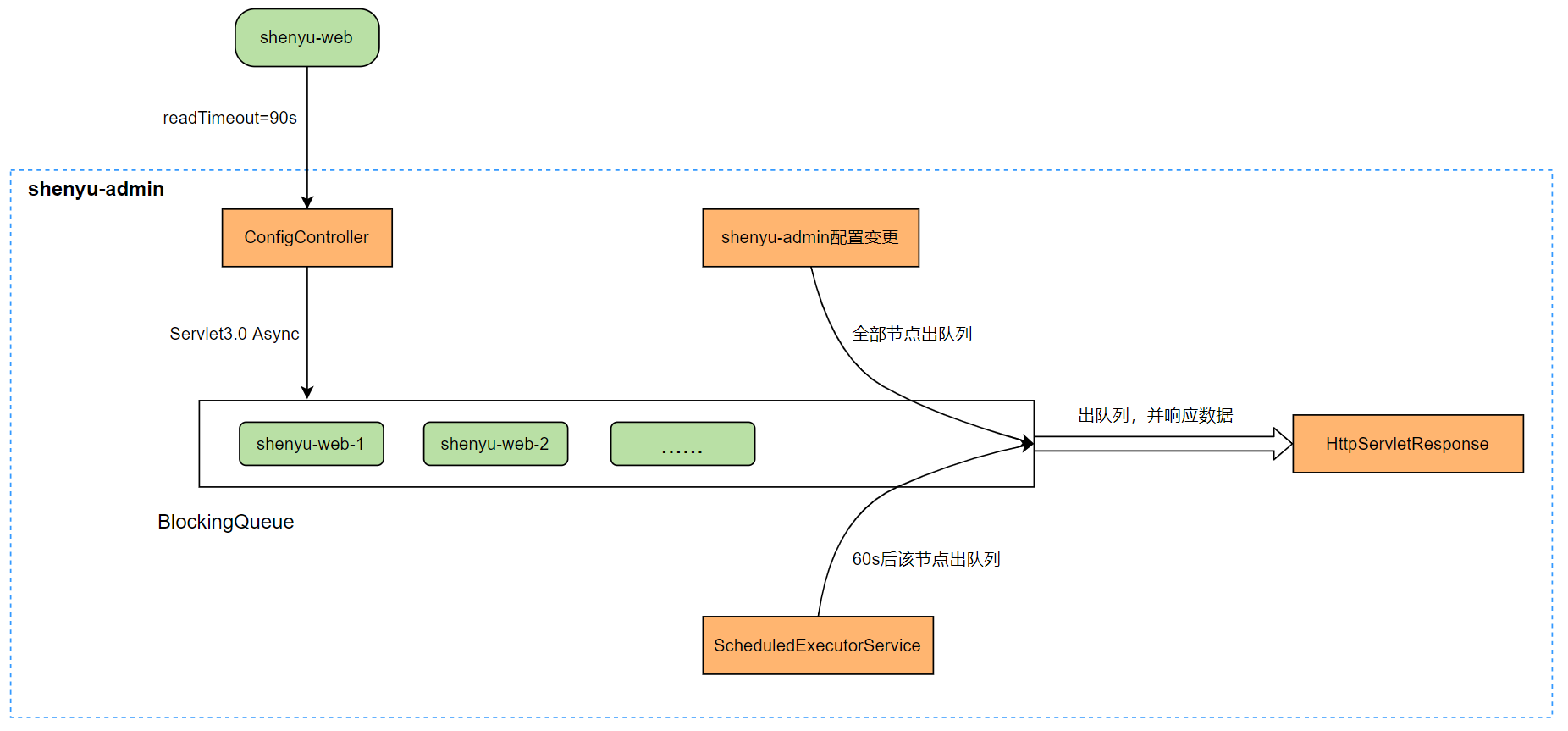

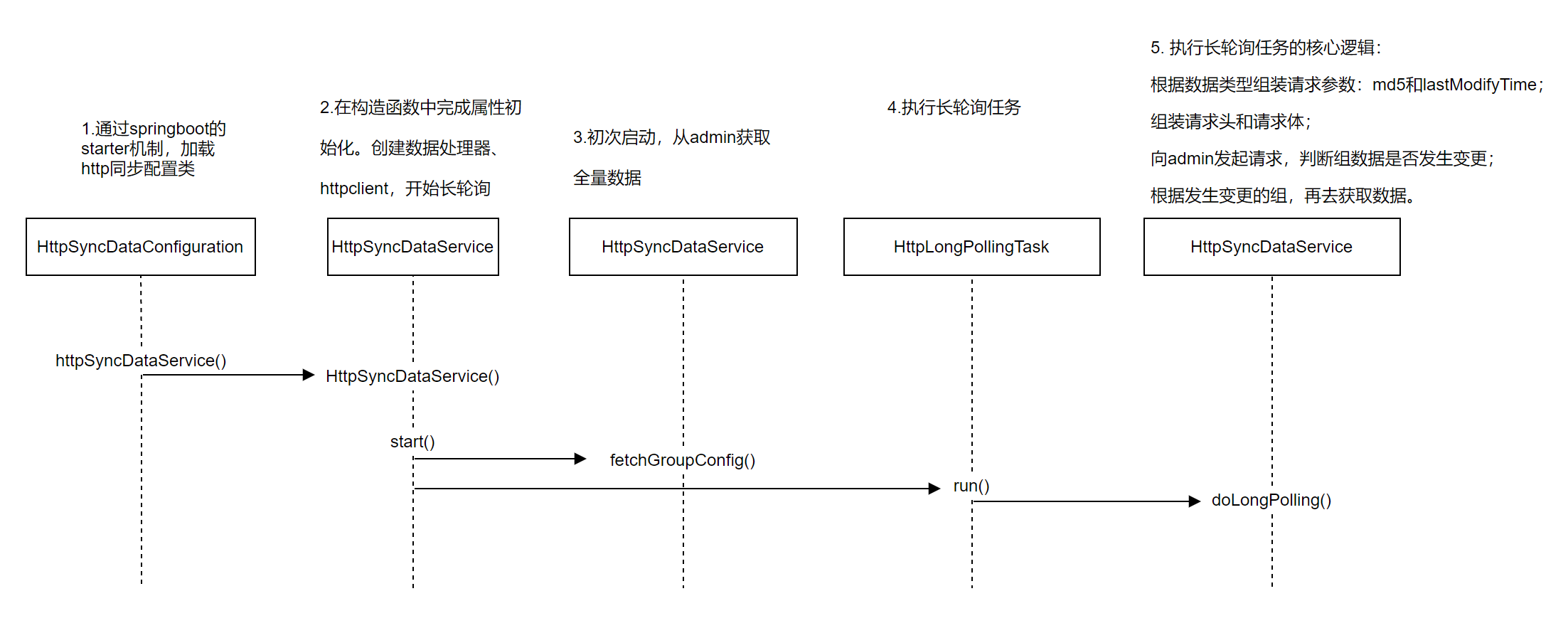
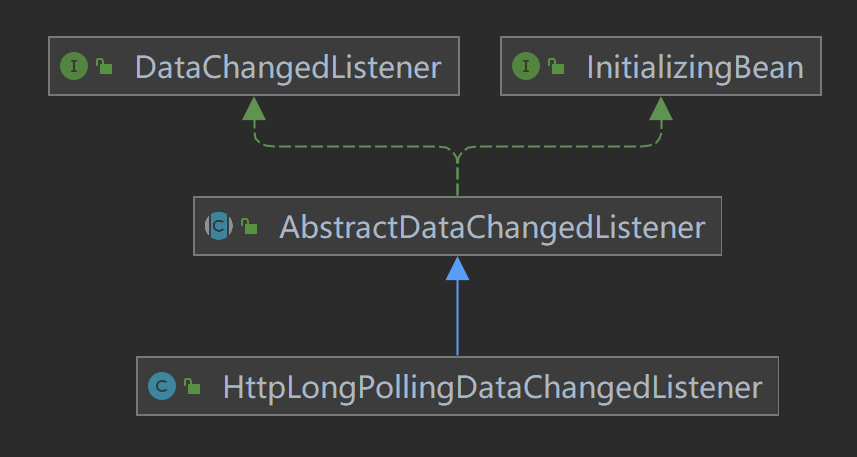

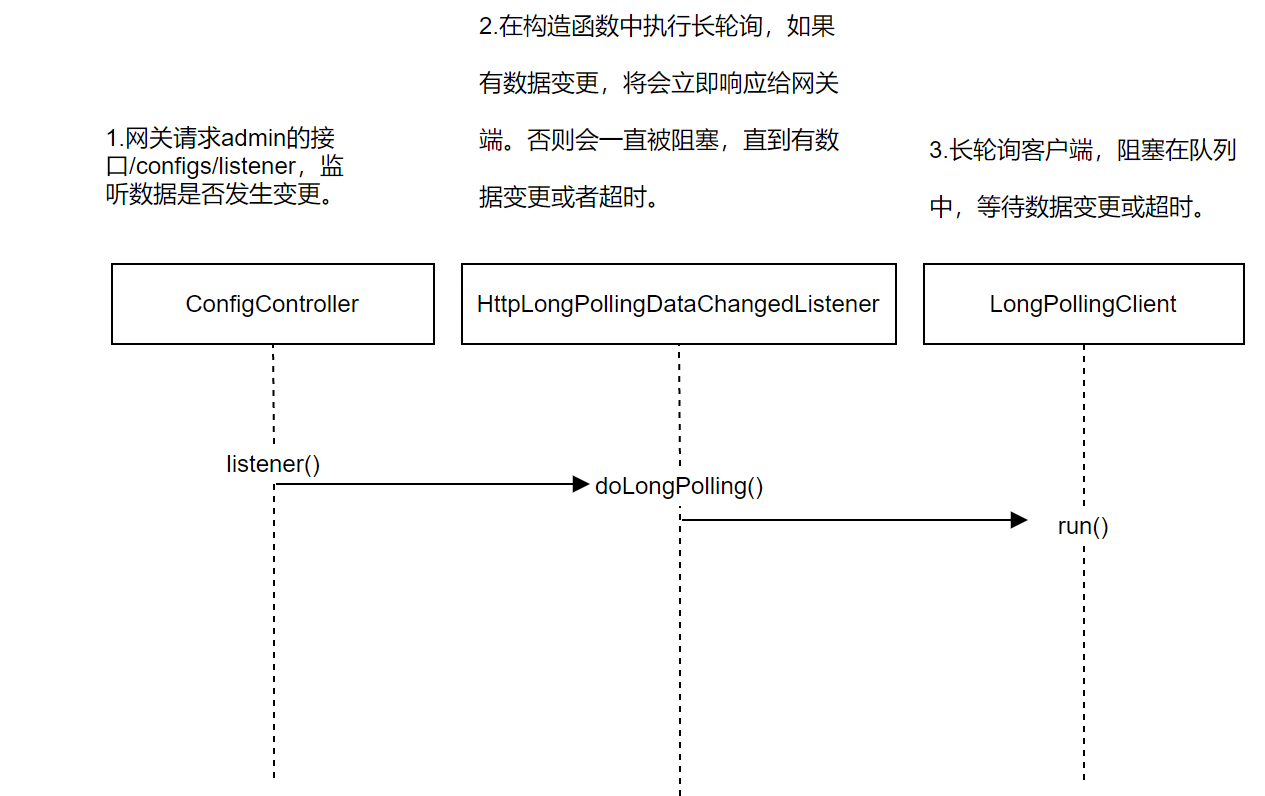
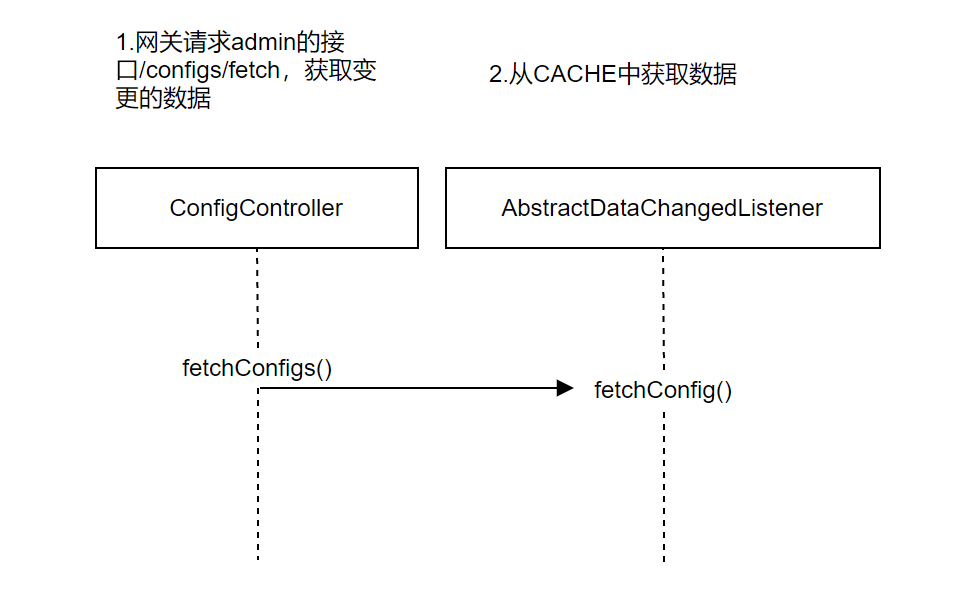













评论